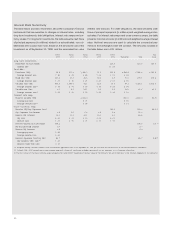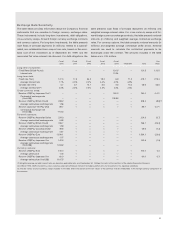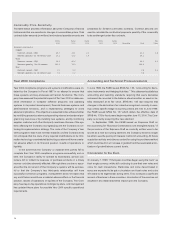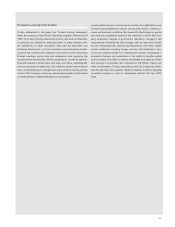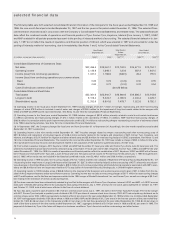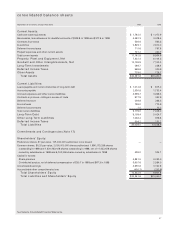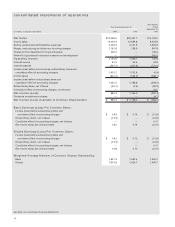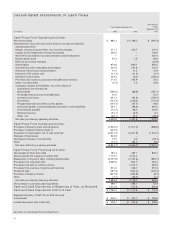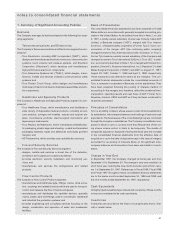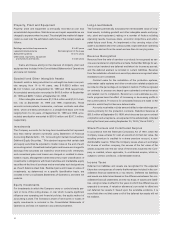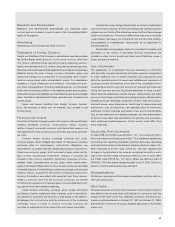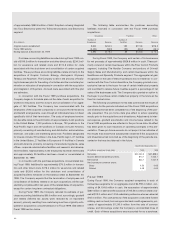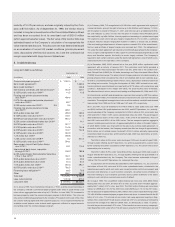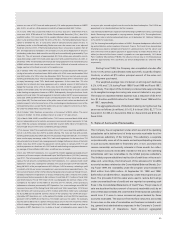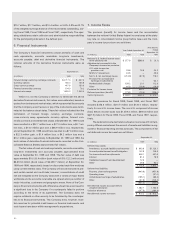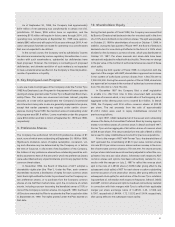ADT 1999 Annual Report Download - page 43
Download and view the complete annual report
Please find page 43 of the 1999 ADT annual report below. You can navigate through the pages in the report by either clicking on the pages listed below, or by using the keyword search tool below to find specific information within the annual report.
41
notes to consolidated financial statements
1. Summary of Significant Accounting Policies
Business
The Company manages its business based on the following four oper-
ating segments:
Telecommunications and Electronics
The Company’s Telecommunications and Electronics segment is com-
prised of:
• Tyco Electronics, including AMP Incorporated (“AMP”), which
designs and manufactures electrical connectors, interconnection
systems, touch screens and wireless systems, and Raychem
Corporation (“Raychem”), which develops and manufactures
high-performance electronic components;
• Tyco Submarine Systems Ltd. (“TSSL”), which designs, manu-
factures, installs and services undersea communications cable
systems; and
• Tyco Printed Circuit Group, which designs and manufactures
multi-layer printed circuit boards, backplane assemblies and sim-
ilar components.
Healthcare and Specialty Products
The Company’s Healthcare and Specialty Products segment is com-
prised of:
• Tyco Healthcare Group, which manufactures and distributes a
wide variety of disposable medical products, including wound-
care products, syringes and needles, sutures and surgical sta-
plers, incontinence products, electrosurgical instruments and
laparoscopic instruments;
• Tyco Plastics and Adhesives, which manufactures flexible plas-
tic packaging, plastic bags and sheeting, coated and laminated
packaging materials, tapes and adhesives and plastic garment
hangers; and
• ADT Automotive, which provides auto redistribution services.
Fire and Security Services
The Company’s Fire and Security Services segment:
• designs, installs and services a broad line of fire detection,
prevention and suppression systems worldwide;
• provides electronic security installation and monitoring ser-
vices; and
• manufactures and services fire extinguishers and related
products.
Flow Control Products
The Company’s Flow Control Products segment:
• manufactures and distributes pipe, fittings, valves, valve actua-
tors, couplings and related products which are used to transport,
control and measure the flow of liquids and gases;
• manufactures and distributes fire sprinkler devices, specialty
valves, plastic pipe and fittings used in commercial, residential
and industrial fire protection systems; and
• provides engineering and consulting services focusing on the
design, construction and operation of water and wastewater
facilities.
Basis of Presentation
The consolidated financial statements have been prepared in United
States dollars in accordance with generally accepted accounting prin-
ciples in the United States. As described more fully in Note 2, on July
2, 1997, a wholly-owned subsidiary of what was formerly called ADT
Limited, a Bermuda company (“ADT”), merged with Tyco Interna-
tional Ltd., a Massachusetts corporation (“Former Tyco”). Upon con-
summation of the merger, ADT (the continuing public company)
changed its name to Tyco International Ltd. (the “Company” or “Tyco”).
Former Tyco became a wholly-owned subsidiary of the Company and
changed its name to Tyco International (US) Inc. (“Tyco US”). In addi-
tion, as more fully described in Note 2, Tyco merged with Inbrand Cor-
poration (“Inbrand”), Keystone International, Inc. (“Keystone”), United
States Surgical Corporation (“USSC”) and AMP on August 27, 1997,
August 29, 1997, October 1, 1998 and April 2, 1999, respectively.
These transactions are referred to herein as the “mergers.” The con-
solidated financial statements include the consolidated accounts of
Tyco, a company incorporated in Bermuda, and its subsidiaries. They
have been prepared following the pooling of interests method of
accounting for the mergers and, therefore, reflect the combined finan-
cial position, operating results and cash flows of ADT, Former Tyco,
Keystone, Inbrand, USSC and AMP as if they had been combined for
all periods presented.
Principles of Consolidation
Tyco is a holding company whose assets consist of its investments in
its subsidiaries, intercompany balances and holdings of cash and cash
equivalents. The businesses of the consolidated group are conducted
through the Company’s subsidiaries. The Company consolidates com-
panies in which it owns or controls more than fifty percent of the vot-
ing shares unless control is likely to be temporary. The results of
companies acquired or disposed of during the fiscal year are included
in the consolidated financial statements from the effective date of
acquisition or up to the date of disposal except in the case of mergers
accounted for as pooling of interests (Note 2). All significant inter-
company balances and transactions have been eliminated in consoli-
dation.
Change in Year End
In September 1997, the Company changed its fiscal year end from
December 31 to September 30. The change in year end resulted in a
short fiscal year covering the nine-month transition period from Janu-
ary 1 to September 30, 1997. References to Fiscal 1999, Fiscal 1998
and Fiscal 1997 throughout these consolidated financial statements
are to the twelve months ended September 30, 1999 and 1998, and
the nine months ended September 30, 1997, respectively.
Cash Equivalents
All highly liquid investments purchased with a maturity of three months
or less are considered to be cash equivalents.
Inventories
Inventories are recorded at the lower of cost (primarily first-in, first-
out) or market value.



